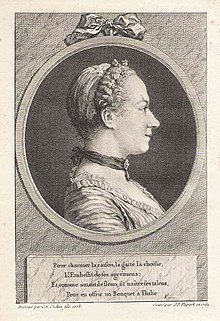Marie Duronceray
Marie Justine Benoîte Duronceray (born June 15, 1727 in Avignon , † April 22, 1772 ), after her marriage to Marie Favart , was a French actress and writer.
Duronceray was a daughter of André René Duronceray and his wife, Perette Claudine Bied; both court musicians of the Polish King Stanislaus I. Leszczyński . Duronceray received her first artistic lessons from her parents and was able to successfully debut as a dancer at Stanislaus' court as a teenager.
Duronceray appeared under the pseudonym "Mlle Chantilly" elsewhere as an actress or dancer. She also met the writer Charles-Simon Favart and married him on December 12, 1745. With him she had a son, who later became actor and writer Charles-Nicolas Favart . As an actress and dancer at the Opéra-Comique , she was able to achieve great success. She played at La Monnaie in Brussels between 1746 and 1748 . Due to competitive pressure, the entrepreneurial couple had to close their own stage. When her husband was instead engaged with a theater company by the Marshal of Saxony, Moritz von Sachsen , she accompanied him on his campaigns to Flanders and Brussels .
Because of the marshal's stalking, she fled to a monastery and was placed under house arrest by him. After his death in 1750, she returned to Paris with her husband. There she was successful as an actress at the Comédie-Italienne for a long time , but gave up dancing. In Belleville she also ran a salon.
In addition to her acting profession, she wrote many plays with her husband. Due to this close cooperation, it is sometimes not possible to clearly distinguish between her and her husband's share. In the joint, ten-volume edition of works by the Favart couple, published by the Paris publishing house Duchesne between 1763 and 1772, a complete volume (vol. 5) is expressly dedicated to Justine Favart's work. These are the following pieces:
- Les amours de Bastien et Bastienne, parodie du Devin de village (1753),
- Lafest d'amour, ou Lucas et Colinette, petite pièce en vers et en un acte (1754),
- Les encorcelés, ou Jeannot et Jeannette, parodie des Surprises de l'amour (1757),
- La fille mal gardée, ou Le pédant amoureux, parodie de la Provençale (1758),
- La fortune au village, parodie d'Églée (1760) and
- Annette et Lubin, comédie en un acte et en vers (1762).
Justine Favart herself starred in each of these pieces. Les amours de Bastien et Bastienne became particularly significant insofar as it became the direct basis for Mozart's Bastien and Bastienne .
Roles (selection)
Duronceray excelled in the representation of character roles and first dared to appear in clothing appropriate to their role. So she embodied country girls in traditional costume or simple linen costumes, sometimes even with bare arms and wooden shoes, instead of the court clothes that were customary up to then.
Trivia
Jacques Offenbach created a musical memorial for her with his Opéra-comique Madame Favart .
literature
- Marie-Justine-Benoîte Favart, Adolphe Blaise: Annette et Lubin, Comédie en un acte en vers, mêlée d'ariettes et de vaudevilles, Historisch-Kritische Hybridedition, Andreas Münzmay, Opera, Janine Droese (eds.), Kassel 2016, ISMN 979-0-006-54318-2 (with a detailed foreword in German, French and English).
- Katharina Hottmann (Ed.): Liedersingen. Studies on the performance history of the song. Olms-Verlag, Hildesheim 2013, ISBN 978-3-487-15101-4 , pp. 75-92.
- Hugo Blank: Rousseau - Favart - Mozart. Six variations on a libretto, Peter Lang, Europäische Verlag der Wissenschaften, Frankfurt am Main 1999, ISBN 3-631-35308-1 , ISSN 0170-9208.
- John Warrack, Evan West: The Oxford dictionary of opera . Clarendon, Oxford 1992, ISBN 0-19-869164-5 .
- Antonius Lux (ed.): Great women of world history. A thousand biographies in words and pictures . Sebastian Lux Verlag , Munich 1963, p. 166.
| personal data | |
|---|---|
| SURNAME | Duronceray, Marie |
| ALTERNATIVE NAMES | Duronceray, Marie Justine Benoîte; Favart, Maria Justine Benedicte; Favart, Marie Justine Benoîte; Mlle Chantilly |
| BRIEF DESCRIPTION | Wife of Charles Simon Favart |
| DATE OF BIRTH | June 15, 1727 |
| PLACE OF BIRTH | Avignon |
| DATE OF DEATH | April 22, 1772 |

